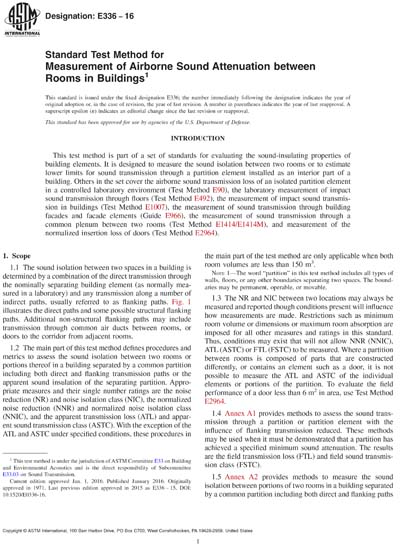Historical
ASTM E336-16
Standard Test Method for Measurement of Airborne Sound Attenuation between Rooms in Buildings
1.1 The sound isolation between two spaces in a building is determined by a combination of the direct transmission through the nominally separating building element (as normally measured in a laboratory) and any transmission along a number of indirect paths, usually referred to as flanking paths. Fig. 1 illustrates the direct paths and some possible structural flanking paths. Additional non-structural flanking paths may include transmission through common air ducts between rooms, or doors to the corridor from adjacent rooms.
1.2 The main part of this test method defines procedures and metrics to assess the sound isolation between two rooms or portions thereof in a building separated by a common partition including both direct and flanking transmission paths or the apparent sound insulation of the separating partition. Appropriate measures and their single number ratings are the noise reduction (NR) and noise isolation class (NIC), the normalized noise reduction (NNR) and normalized noise isolation class (NNIC), and the apparent transmission loss (ATL) and apparent sound transmission class (ASTC). With the exception of the ATL and ASTC under specified conditions, these procedures in the main part of the test method are only applicable when both room volumes are less than 150 m3.
1.3 The NR and NIC between two locations may always be measured and reported though conditions present will influence how measurements are made. Restrictions such as minimum room volume or dimensions or maximum room absorption are imposed for all other measures and ratings in this standard. Thus, conditions may exist that will not allow NNR (NNIC), ATL (ASTC) or FTL (FSTC) to be measured. Where a partition between rooms is composed of parts that are constructed differently, or contains an element such as a door, it is not possible to measure the ATL and ASTC of the individual elements or portions of the partition. To evaluate the field performance of a door less than 6 m2 in area, use Test Method E2964.
1.4 Annex A1 provides methods to assess the sound transmission through a partition or partition element with the influence of flanking transmission reduced. These methods may be used when it must be demonstrated that a partition has achieved a specified minimum sound attenuation. The results are the field transmission loss (FTL) and field sound transmission class (FSTC).
ASTM International [astm]

